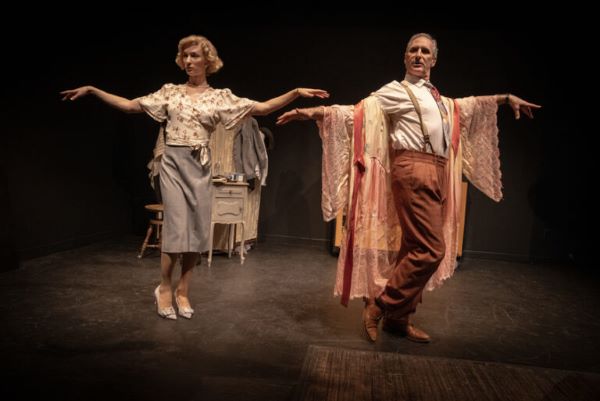
In 1952, Christine Jorgensen (1926-89), born George William Jorgensen of Danish parents, raised in the Bronx, NY, and a veteran of WWII, became the first American to become known for having gender reassignment surgery, or a sex-change operation, as it was then called, in Copenhagen. Her transition became front-page news, and she became a worldwide celebrity, performer, and advocate for transgender people, who told her story in her 1967 best-seller Christine Jorgensen: A Personal Autobiography. Produced by wild project productions and ADH Theatricals, The Christine Jorgensen Show, with book, music, and lyrics by Donald Steven Olson, takes a look at the development of Jorgensen’s trailblazing career on the stage, along with that of Myles Bell, a long-forgotten song-and-dance man, composer and pianist, and recovering alcoholic, who helped her create a popular nightclub act that “transformed her from headline into headliner.”

Directed by Michael Barakiva and Zoë Adams, the two-hander features transgender actress Jesse James Keitel (a regular on the ABC TV series Big Sky) in the titular role, with cabaret artist Mark Nadler as Bell, tracing Jorgensen’s career from their first meeting at his studio, arranged by their mutual agent, through the ups and downs of their evolving partnership, to the debut performance of their show. Presented in the intimate black box theater of 59E59, the minimal set by Shoko Kambara, with props by Samantha Shoffner, contains just an upright piano on wheels, with a chair, piano stool, dressing screen draped with clothing, a tray with cocktail glasses and bourbon on a small end table, and a crystal chandelier – all key elements in defining the interests of the real-life characters – music, dance, performing, fashion, and “a little sip when nervous, lonely, or frightened” – and all well-captured in the engaging story and compelling portrayals by a profoundly empathetic Keitel and in the musical mastery of Nadler.
The initial meeting between a prim and proper Jorgensen and the “insulting, rude, and disrespectful” Bell gets off to a rocky start. He immediately assumes that she is a secretary or “window dressing” (not the intended star of the act in which he will just be “featured”), in keeping with the mid-century attitudes towards women. She is at first nervous and reluctant about singing and dancing, having no previous experience but for a Danish Christmas carol she sang at home with her family. They exchange gibes but also reveal themselves and their sincere motivations: he wants to make a comeback in show biz and continue to do what he loves; she wants “to tell her story, to open a few minds, and to help a few people.” Though very different in demeanor, both are determined and self-assured, both are three-dimensional and likeable human beings, and both come to understand and to appreciate one another, as they agree upon the importance of “listening to your inner voice – the voice inside your heart.”

Through their many sessions in the studio (the change of days signaled by Keitel’s exits and entries, and shifts in lighting by Calvin Anderson), the energetic Bell develops the songs and choreography for the show, teaches the reserved Jorgensen the rudiments of how to sing and dance, how to do the “showgirl walk,” and encourages her to loosen up, show some humor and sex appeal, and to show her legs (in a funny scene that begins to break the ice between them). She relies on him to listen to her acceptance speech for her Woman of the Year Award from the Scandinavian Societies of New York (with him injecting some hilarious Danish accents and an imitation of Danish-American comedian-pianist Victor Borge) and to teach her how to waltz, in case someone asks her to dance, and, in so doing, they begin to joke, to touch, and to grow closer. Her skills in singing and moving steadily improve, and despite a bout of stage fright, culminate in a final scene of their entertaining, charming, and simpatico nightclub premiere, with their singing and tap dancing interspersed with amusing banter and rapport, and acknowledgment of how much they’ve helped and supported each other.

The enjoyable music (enhanced by Jacqui Herter’s clear sound) and movement (choreography by Banji Aborisade) authentically recreate the evolution of Jorgensen’s talent and the stylings of the era as embodied by Bell, as does the array of costumes by Suzanne Chesney that suit the period, personalities, and situations.
With its focus on personal interactions and growing understanding, The Christine Jorgensen Show shines a spotlight on a groundbreaking figure in LGBTQ+ history and on a the lesser-known ally who aided in getting “the voice inside her heart” heard. It’s a beautiful message of camaraderie and acceptance that is as valid now as it was in the 1950s.
Running Time: Approximately one hour and 40 minutes, without intermission.


The Christine Jorgensen Show plays through Sunday, March 3, 2024, at 59E59, 59 East 59th Street, NYC. For tickets (priced at $37, including fees), go online.



